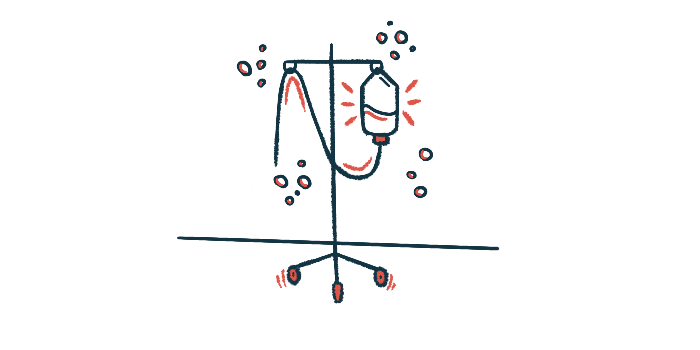Ocrevus Reduces Disease Activity, Slows Progression in RRMS, PPMS
Therapy works by killing off antibody-producing B-cells involved in inflammatory responses

Ocrevus (ocrelizumab) was equally effective in reducing disease activity after two years in people with primary progressive multiple sclerosis (PPMS) and relapsing-remitting multiple sclerosis (RRMS), a new study reports.
The therapy also slowed disease progression in both groups, although a stronger effect was seen with RRMS patients in the second year of treatment.
The study, “Relapsing-remitting and primary progressive multiple sclerosis treated with ocrelizumab: A comparative study,” was published in Multiple Sclerosis and Related Disorders.
Ocrevus, developed by Genentech, is a disease-modifying therapy for multiple sclerosis (MS) that works by killing antibody-producing B-cells, which are involved in the damaging inflammatory responses driving MS. It’s approved for treating relapsing forms of MS and is the only approved treatment for PPMS to date.
While PPMS and RRMS are very different disease forms, few real-world studies have compared Ocrevus’ effects with these two MS types since its approval. Most existing data is related to safety, but “differences in clinical and radiological responses to [Ocrevus] in both clinical forms have not been fully investigated,” the researchers wrote.
Comparing Ocrevus’ effects in RRMS, PPMS
Researchers from Spain compared the disease course in RRMS and PPMS patients treated with Ocrevus for at least a year. They used data from patients treated at a single MS center from January 2018 to October 2021.
A total of 42 adults – 29 with RRMS and 13 with PPMS – were included in the analysis (mean age, 44). PPMS patients were generally older, with a longer disease duration, and had more disability than those with RRMS. These patients received a mean 5.7 cycles of Ocrevus treatment and their follow-up lasted an average of 31.5 months. RRMS patients received a mean 4.1 cycles and were followed for a mean of 24.2 months.
After initiation, follow-up visits were every three months and MRI assessments were done once a year.
Ocrevus was effective at reducing relapses in RRMS patients, who had an annualized relapse rate of 0.17 after one year of treatment and 0.05 in the second year compared with 0.21 the year before treatment. This rate represents a patient’s average number of relapses per year.
Regarding radiological activity, 80% of RRMS patients had no new lesions in MRI scans after a year of Ocrevus and no new lesions were found in the second year. Similar effects were seen in PPMS patients. After one year, 91.7% had no new lesions and none were detected in the second year.
Disability progression compared with Ocrevus
Disability progression was defined as a sustained increase in Expanded Disability Status Scale (EDSS) scores lasting at least three months. At one year, two RRMS patients (7.1%) had disability progression and three (10.7%) had sustained disability improvements (or less disability). In the second year, one patient (4.8%) worsened and five (25%) improved.
A similar proportion of PPMS patients worsened (7.7%) and improved (10.7%) in the first year. However, compared with RRMS patients, there were more patients with disability progression in the second year (36.4%) and fewer with disability improvements (9.1%).
Both RRMS and PPMS patients had less disability progression after starting Ocrevus than in the year before starting it, although the effects began to wear off in the second year for PPMS patients.
Combining radiological and clinical findings, 18 RRMS patients (69.2%) and 10 PPMS patients (90%) had no evidence of disease activity or progression (NEDA) at one year, meaning they had no relapses, no disability worsening, and no new lesions. After two years, NEDA rates increased in RRMS patients with NEDA to 80%, but decreased in PPMS patients to 63.6%, possibly accounting for the greater number of patients with disability worsening.
This result points to a different treatment effect of Ocrevus in disability progression across the two groups. “We have observed that progression continues at a slower rate in pwPPMS [people with PPMS], especially after one year of treatment, while it is practically stopped in pwRRMS [people with RRMS],” the researchers wrote, noting that their “observation should be taken with caution due to the small number of patients analyzed and the impossibility of performing a broader statistical analysis.”
The assessment of safety and tolerance of Ocrevus showed no statistical differences between RRMS and PPMS patients. Overall, 42.5% of patients reported at least one side effect. This proportion was similar between the first (42.8%) and second (41.9%) years.
The most common side effects were infusion-site reactions and infections. All were deemed mild, although infections caused one PPMS patient to discontinue treatment in the second year. Other frequent side effects were blood-related complications. These were more frequent in the first year and caused three RRMS patients to discontinue treatment in that year.
Overall, “ocrelizumab was very effective in reducing relapses and MRI activity. The rate of progression was slowed down; however, the effect was more evident for pwRRMS than for pwPPMS over time,” the researchers concluded, adding despite this difference between groups, the study shows “a clear difference in the speed of [disability] progression before and after ocrelizumab” in both disease types.







